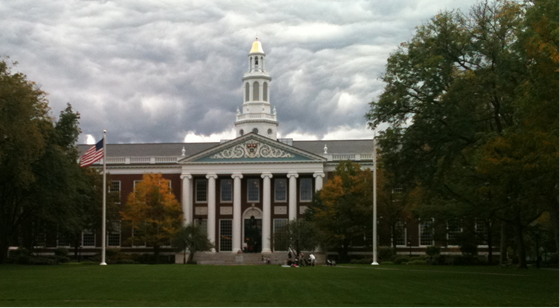Autumn is the best time to visit the other Cambridge – the Harvard one – and I’m here on the day that the boat race called ‘Head of the Charles’ is taking place outside my window.
This week I am fortunate enough to be attending a management training course at Harvard Business School, on the subject of Corporate Social Responsibility, or CSR.
The surroundings are impressive – historic Harvard Square, walks along the Charles River into the quaint centre of Cambridge – Boston’s sister city across the river.
The accommodation is basic – an upgraded student dorm room – but the food is more corporate than canteen, and the Federal architecture of the low rise campus is very calm and soothing.
The real reason to be there is to share in the unparalleled knowledge of the world of business which HBS provides. A wealth of global experts – like Michael Porter, the world’s leading authority on creating competitive advantage – stalk the hallowed halls.
I’m here to learn about building partnerships with corporates and NGOs, around the concept of investing in the creation of social benefits to parallel business benefits.
 The participants represent a range of corporations – the big four professional service firms, big pharma, oil and gas, hi-tech – and are mostly focused on how they should build a CSR strategy that will help them reap both the reputational and the business benefits.
The participants represent a range of corporations – the big four professional service firms, big pharma, oil and gas, hi-tech – and are mostly focused on how they should build a CSR strategy that will help them reap both the reputational and the business benefits.
Learning here is based around the case study method, a form of Socratic dialogue where the professors lead in-depth discussions to analyse the theory and practice embedded in the real-world consequences of corporate actions researched and summarised in the case studies.
CSR used to be about philanthropy – giving money to worthy causes – but it is now moving into an era of CSV – creating shared value. When a corporate can invest in a new approach to business, in partnership with an NGO or social enterprise, that aligns closely to their corporate strategy and activity but in addition brings social benefits and supports the local community – then it’s a win-win, and a benefit that is more sustainable than a simple donation.
What’s clear is that companies are looking for new ways to build partnerships that benefit their double bottom line – their financial interests and their broader social and reputational objectives, and this is an area where the ELT world can make a contribution by helping corporates link up with educational and social benefit projects worldwide.

